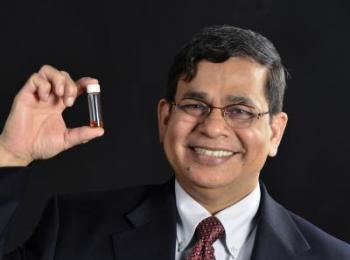Apr 18 2014
New therapies are needed to prevent and treat respiratory syncytial virus (RSV) – a potentially lethal respiratory infection that can severely affect infants, young children and the elderly.
 Shyam Mohapatra, Ph.D., leads the VA/University of South Florida research team with expertise in nanoparticle technology. He holds a test tube of nanoparticle solution. Credit: © University of South Florida
Shyam Mohapatra, Ph.D., leads the VA/University of South Florida research team with expertise in nanoparticle technology. He holds a test tube of nanoparticle solution. Credit: © University of South Florida
Despite a wide range of anti-RSV efforts, there are no vaccines or drugs on the market to effectively prevent or treat the infection.
Now researchers at the Dana-Farber/Boston Children's Cancer and Blood Disorders Center and Harvard Medical School in Boston, MA, and the James A. Haley VA Hospital and the University of South Florida (USF) in Tampa, FL, have developed novel double-stapled peptides that inhibit RSV in cells and in mice. The team also showed that this peptide's capacity to block infection was significantly boosted when delivered to the lungs by miniscule, biodegradable particles known as nanoparticles.
The team's findings are reported online today in The Journal of Clinical Investigation.
RSV employs a fusion protein with a helical structure to enable the virus to bind to and penetrate epithelial cells lining the nose and lungs.
The Dana-Farber/Boston Children's/Harvard laboratory led by co-senior author Loren Walensky, MD, PhD, used their chemical strategy known as hydrocarbon stapling to make "double-stapled" RSV peptides. Stapling helps the peptides retain their natural helical shape and resist degradation by the body's enzymes while disrupting the fusion process needed for RSV to infect host cells.
The VA/USF group led by co-senior author Shyam Mohapatra, PhD, tested these double-stapled peptides, alone and in combination with propriety nanoparticles, in mice to demonstrate significant inhibition of RSV infection.
"This is an exciting advance in the fight against respiratory syncytial virus infection," said Dr. Mohapatra, director of the USF Nanomedicine Research Center and the USF Health Morsani College of Medicine's Division of Translational Medicine, and a research career scientist at James A. Haley VA Hospital.
"We found that double-stapled peptide interference targeting the virus fusion protein can be administered in the form of a nasal drop or spray. The treatment suppressed viral entry and reproduction, including spread from nose to lungs, providing substantial protection from infection when administered several days before viral exposure."
"Designing therapeutic peptides based on a virus' very own fusion apparatus was previously exploited to block HIV-1 infection, but this class of drugs was severely limited by the pharmacologic liabilities of peptides in general, including loss of bioactive structure and rapid digestion in the body," said Dr. Walensky, associate professor of pediatrics at Harvard Medical School, pediatric hematologist/oncologist at Dana-Farber/Boston Children's and principal investigator in Dana-Farber's Linde Program in Cancer Chemical Biology.
"Peptide stapling restores the natural helical shape, which also inhibits proteolysis, providing a new opportunity to take advantage of a well-validated mechanism of action to thwart viruses like RSV that otherwise lack drugs for preventing or treating infection."
Dr. Mohapatra and his team developed nose drops containing the Walensky laboratory's double-stapled peptides after combining them with TransGenex's chitosan nanoparticles that stick to mucous-producing cells lining the lungs.
First, the researchers treated mice intranasally with stapled peptide nose drops, both before and during infection with RSV. The treated mice showed significantly lower levels of virus in the nose and lungs, and less airway inflammation, compared to untreated mice.
Then, double-stapled peptides encapsulated in nanoparticles were delivered to the lungs via the trachea to test whether the combination could further increase the effectiveness of this experimental therapy. The nanoparticle preparation markedly improved delivery of the peptides to the lungs, and the combination worked better and longer in preventing RSV pneumonia than the double-stapled peptide alone.
The researchers say to the best of their knowledge this preclinical study is the first to combine peptide stapling and nanoparticle technologies to maximize the delivery, persistence, and effectiveness of an antiviral therapy.
RSV is the most common virus causing lung and airway infections in infants and young children. Most have had this infection by age 2, and it can be especially serious, even deadly, in high-risk groups, such as babies born prematurely and those whose immune systems do not work well. The virus hospitalizes thousands of infants each year for pneumonia or brochiolitis and has been associated with a significantly greater risk of developing asthma later in life. The elderly are also at high risk of complications from RSV infection.
"This is a new way forward in the development of strategies to prevent RSV infection," said Terrence Dermody, MD, the Dorothy Overall Wells professor of pediatrics and director of the Division of Pediatric Infectious Diseases at Vanderbilt University School of Medicine, who was not involved with the research. "The authors are to be complimented on the clever design, interdisciplinary approach and extension from cell-culture experiments to animal studies. I am particularly excited about the possible application of this technology to other viruses."